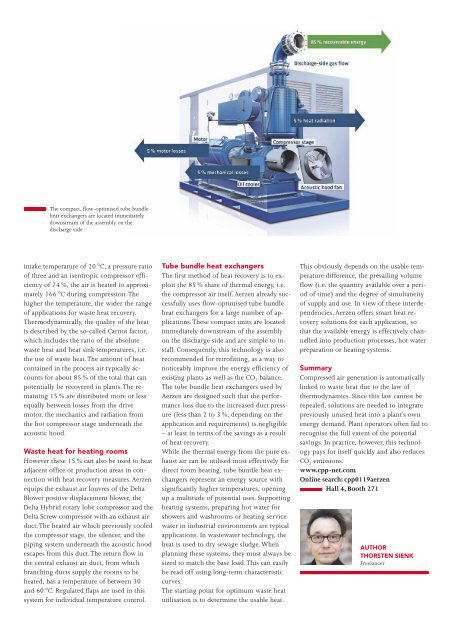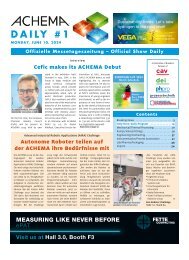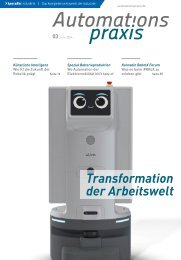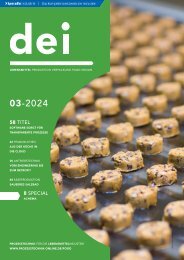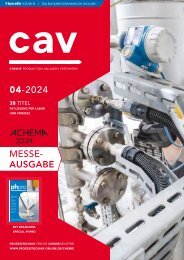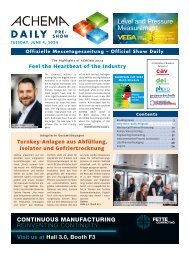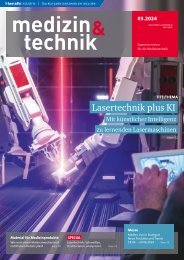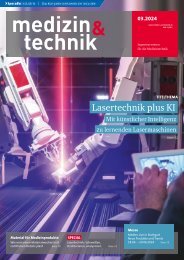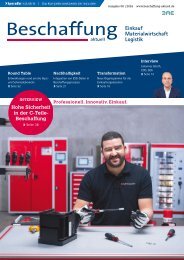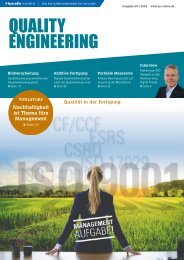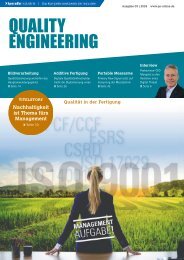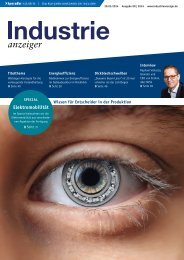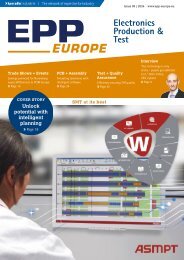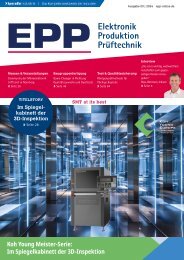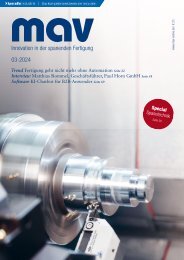cpp – Process technology for the chemical industry 01.2019
The journal cpp - Process technology for the chemical industry reports about processes, plants, apparatus and components for the chemical and pharmaceutical industry. Further topics are IT technologies, industry 4.0, digital production, MSR and automation technology and process analysis technology. The content spectrum is rounded off by explosion protection, plant safety, occupational health and safety, maintenance, site management and energy management.
The journal cpp - Process technology for the chemical industry reports about processes, plants, apparatus and components for the chemical and pharmaceutical industry. Further topics are IT technologies, industry 4.0, digital production, MSR and automation technology and process analysis technology. The content spectrum is rounded off by explosion protection, plant safety, occupational health and safety, maintenance, site management and energy management.
You also want an ePaper? Increase the reach of your titles
YUMPU automatically turns print PDFs into web optimized ePapers that Google loves.
The compact, flow-optimised tube bundle<br />
heat exchangers are located immediately<br />
downstream of <strong>the</strong> assembly on <strong>the</strong><br />
discharge side<br />
intake temperature of 20 °C, a pressure ratio<br />
of three and an isentropic compressor efficiency<br />
of 74 %, <strong>the</strong> air is heated to approximately<br />
166 °C during compression. The<br />
higher <strong>the</strong> temperature, <strong>the</strong> wider <strong>the</strong> range<br />
of applications <strong>for</strong> waste heat recovery.<br />
Thermodynamically, <strong>the</strong> quality of <strong>the</strong> heat<br />
is described by <strong>the</strong> so-called Carnot factor,<br />
which includes <strong>the</strong> ratio of <strong>the</strong> absolute<br />
waste heat and heat sink temperatures, i.e.<br />
<strong>the</strong> use of waste heat. The amount of heat<br />
contained in <strong>the</strong> process air typically accounts<br />
<strong>for</strong> about 85 % of <strong>the</strong> total that can<br />
potentially be recovered in plants. The remaining<br />
15 % are distributed more or less<br />
equally between losses from <strong>the</strong> drive<br />
motor, <strong>the</strong> mechanics and radiation from<br />
<strong>the</strong> hot compressor stage underneath <strong>the</strong><br />
acoustic hood.<br />
Waste heat <strong>for</strong> heating rooms<br />
However <strong>the</strong>se 15 % can also be used to heat<br />
adjacent office or production areas in connection<br />
with heat recovery measures. Aerzen<br />
equips <strong>the</strong> exhaust air louvres of <strong>the</strong> Delta<br />
Blower positive displacement blower, <strong>the</strong><br />
Delta Hybrid rotary lobe compressor and <strong>the</strong><br />
Delta Screw compressor with an exhaust air<br />
duct. The heated air which previously cooled<br />
<strong>the</strong> compressor stage, <strong>the</strong> silencer, and <strong>the</strong><br />
piping system underneath <strong>the</strong> acoustic hood<br />
escapes from this duct. The return flow in<br />
<strong>the</strong> central exhaust air duct, from which<br />
branching ducts supply <strong>the</strong> rooms to be<br />
heated, has a temperature of between 30<br />
and 60 °C. Regulated flaps are used in this<br />
system <strong>for</strong> individual temperature control.<br />
Tube bundle heat exchangers<br />
The first method of heat recovery is to exploit<br />
<strong>the</strong> 85 % share of <strong>the</strong>rmal energy, i.e.<br />
<strong>the</strong> compressor air itself. Aerzen already successfully<br />
uses flow-optimised tube bundle<br />
heat exchangers <strong>for</strong> a large number of applications.<br />
These compact units are located<br />
immediately downstream of <strong>the</strong> assembly<br />
on <strong>the</strong> discharge side and are simple to install.<br />
Consequently, this <strong>technology</strong> is also<br />
recommended <strong>for</strong> retrofitting, as a way to<br />
noticeably improve <strong>the</strong> energy efficiency of<br />
existing plants as well as <strong>the</strong> CO 2 balance.<br />
The tube bundle heat exchangers used by<br />
Aerzen are designed such that <strong>the</strong> per<strong>for</strong> -<br />
mance loss due to <strong>the</strong> increased duct pressure<br />
(less than 2 to 3 %, depending on <strong>the</strong><br />
application and requirements) is negligible<br />
<strong>–</strong> at least in terms of <strong>the</strong> savings as a result<br />
of heat recovery.<br />
While <strong>the</strong> <strong>the</strong>rmal energy from <strong>the</strong> pure exhaust<br />
air can be utilised most effectively <strong>for</strong><br />
direct room heating, tube bundle heat exchangers<br />
represent an energy source with<br />
significantly higher temperatures, opening<br />
up a multitude of potential uses. Supporting<br />
heating systems, preparing hot water <strong>for</strong><br />
showers and washrooms or heating service<br />
water in industrial environments are typical<br />
applications. In wastewater <strong>technology</strong>, <strong>the</strong><br />
heat is used to dry sewage sludge. When<br />
planning <strong>the</strong>se systems, <strong>the</strong>y must always be<br />
sized to match <strong>the</strong> base load. This can easily<br />
be read off using long-term characteristic<br />
curves.<br />
The starting point <strong>for</strong> optimum waste heat<br />
utilisation is to determine <strong>the</strong> usable heat.<br />
This obviously depends on <strong>the</strong> usable temperature<br />
difference, <strong>the</strong> prevailing volume<br />
flow (i.e. <strong>the</strong> quantity available over a period<br />
of time) and <strong>the</strong> degree of simultaneity<br />
of supply and use. In view of <strong>the</strong>se interdependencies,<br />
Aerzen offers smart heat recovery<br />
solutions <strong>for</strong> each application, so<br />
that <strong>the</strong> available energy is effectively channelled<br />
into production processes, hot water<br />
preparation or heating systems.<br />
Summary<br />
Compressed air generation is automatically<br />
linked to waste heat due to <strong>the</strong> law of<br />
<strong>the</strong>rmodynamics. Since this law cannot be<br />
repealed, solutions are needed to integrate<br />
previously unused heat into a plant’s own<br />
energy demand. Plant operators often fail to<br />
recognise <strong>the</strong> full extent of <strong>the</strong> potential<br />
savings. In practice, however, this <strong>technology</strong><br />
pays <strong>for</strong> itself quickly and also reduces<br />
CO 2 emissions.<br />
www.<strong>cpp</strong>-net.com<br />
Online search: <strong>cpp</strong>0119aerzen<br />
Hall 4, Booth 271<br />
AUTHOR:<br />
THORSTEN SIENK<br />
Freelancer


